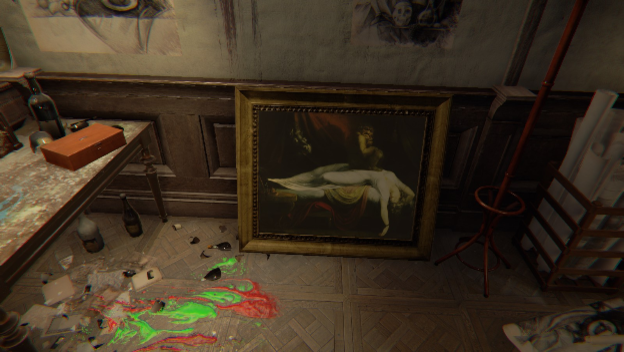Warning: Spoilers for Layers of Fear ahead!
Layers of Fear is an Indie horror game that came out earlier this year by the Bloober Team. It is a first-person psychedelic horror game with a heavy focus on story and exploration. Players take control of a painter whose sole purpose is to finish his masterpiece.
Layers of Fear is unique horror game because of it’s rather accurate portrayal of a deteriorating mental state. I would even go so far as to claim that the main character suffers from schizophrenia, however the evidence is limited due to the nature of the game itself. Nonetheless, the hallucinations, emotional outbursts, psychopathic tendencies, and his paintings, all point towards schizophrenia.
Schizophrenia is defined in the DSM-5 , the Diagnostic and Statistical Manual of Mental Disorders, as when at least two of the following symptoms are present for a significant portion of time during a 1-month period or longer. At least one of these symptoms must be the clear: presence of delusions, hallucinations, or disorganized speech. Individuals may express a variety of unusual or odd beliefs (e.g., ideas of reference or magical thinking); they may have unusual perceptual experiences (e.g., sensing the presence of an unseen person); their speech may be generally understandable but vague; and their behavior may be unusual but not grossly disorganized (e.g., mumbling in public).
Now, let’s take a look at Layers of Fear . First and foremost, are the painter’s hallucinations. Hallucinations under schizophrenia in the DSM-5 are defined as vivid and clear, with the full force and impact of normal perceptions, and not under voluntary control. The player is quite literally inside the mind of a madman as his mental state deteriorates. Thus all the experiences within the game are entirely subject to this – each time you hear the child’s laughter, or the wife’s voice, for example. As such, the house isn’t really haunted, the walls aren’t really rotting away, and there actually is no rat infestation. Each “scare” scene is simply another step towards madness, an illusion inside the head of the master painter. Indeed, when the rooms themselves begin to contort, the blurred hallways, the moving paintings, are all very clear symptoms of the hallucinations found in schizophrenia. They reflect the painter’s state of mind in a way most horror games fall short of. Such ongoing visions of distorted reality are made all the more realistic by staying true to symptoms of schizophrenia.
Hallucinations are not the only common symptom of schizophrenia and Layers of Fear , however. Holding unusual beliefs and vague, slightly disorganized speech. For example, the painter expresses the very unusual belief that if he finishes his masterpiece, all his problems will be solved. This is essentially the entire point of the game and the most obvious besides the hallucinations. Disorganized speech can be found nearly every time the painter speaks, the player has to sift through a lot of nonsense to get at true meaning. For example, the very first few lines in the opening scene “I still hear the scratching in my head… deeper and deeper and… My hands, cut so many times on broken bottles”. In retrospect, this phrase makes a kind of sense. The scratching might refer to his firmly held belief that the house is infested with rats. The broken bottles might refer to his alcoholism, and the very abundant amount of broken glass throughout the house. The two concepts, however, don’t really connect. Rats and broken bottles don’t usually have a lot in common.

Furthermore, the paintings hung throughout the game are clear and quite poetic reflections of the painter’s schizophrenic mind. Although they do not refer specifically to schizophrenia as most other incidents in the game do, I believe them to be equally important. It felt like I was looking through a window into the painter’s mind as I observed each of them; the depictions of the Black Plague , The Nightmare by Henry Fuseli, and plenty of other equally famous paintings, each have their own intricate story, all originating in mystery, brutality, and violent acts. Fuseli’s The Nightmare, for example , falls under the example of mystery, true to the romantic period it comes from. The interpretations of this painting vary greatly, however the mystery of this painting does stem from the elusive state of dream and the apparently intangible demons of the mind. This suggests an apt parallel to the artist’s mental state; though the view is a bit archaic, mental illnesses were once thought to be the work of supernatural demons.
Layers of Fear is certainly one of the few horror games that depict schizophrenia in a unique and accurate way. The “madness” that drove the paintings’ narrative, either of the artist or the story they painted, clearly reflected the main character’s mental state. In addition, the game includes very strong symptoms pointing towards schizophrenia such as hallucinations, disorganized speech, and unusual beliefs. They added a layer, if you will, to the game’s madness.
